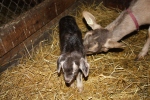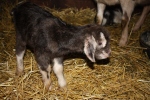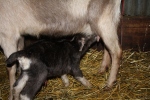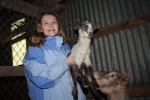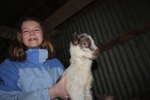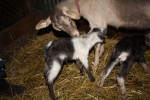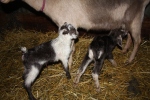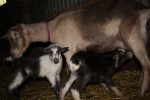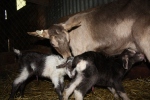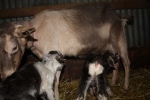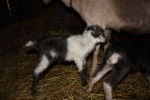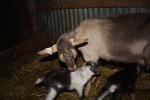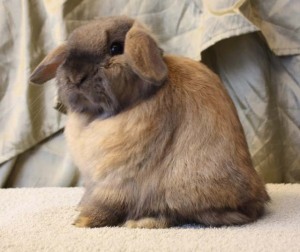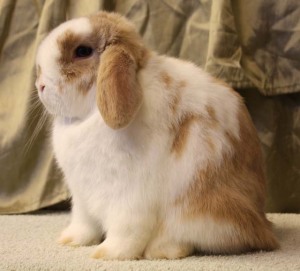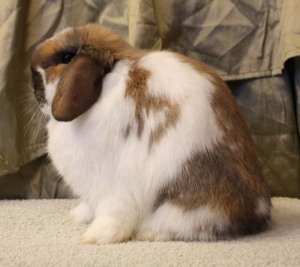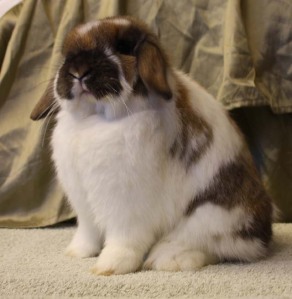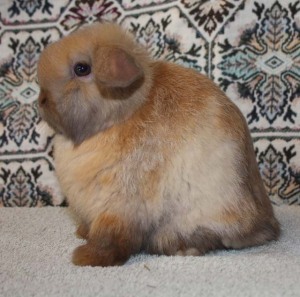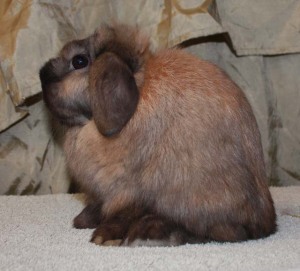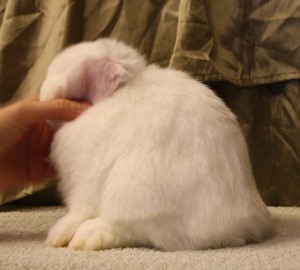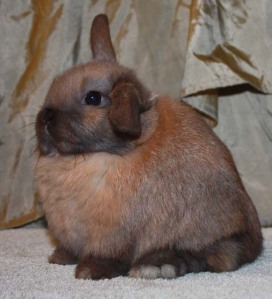Saturday (March 5th) was Abby’s 13th birthday. And what a birthday it was. She spent the day sequestered at the Notre Dame Stepan Center for the Northern Indiana Regional Science & Engineering Fair. This was Abby’s fourth year attending (she’s in the 7th grade this year). She did incredibly well! Six awards, including a $10K scholarship to Bethel College and the top Physical Science Project in the Junior Division (middle school). So, Abby will be attending the state science fair, to be held in Bloomington, IN this year.
Abby Does Well at NIRSEF
09 Mar 2011 Leave a comment
in Uncategorized Tags: Bethel College, Indiana, Middle school, Science fair
First Baby Goats of the Year!
09 Mar 2011 2 Comments
JuJu Bean surprised me with a little buck kid when I walked into the barn yesterday afternoon. He hadn’t been born long – was just trying to stand on his tottering legs. I ran into the house, grabbed an old towel and ran back out to the barn out with it so I could dry him off more. A few minutes later, I looked up and JuJu was pushing out another kid. I broke the sac around it’s face and saw that one leg was forward (like it should be) but the other was back. All she needed was a gentle pull and she came right out. A little doe.
Giraffes join guests at the breakfast table in African hotel – Telegraph
26 Jan 2011 Leave a comment
Frustration
20 Jan 2011 Leave a comment
I REALLLLY dislike this time of year here in Michiana. It’s just too darn cold… for bunny breedin’ and birthin’ anyway. My barn is not heated and so when it is cold outside, it’s cold inside. I’ve had a terrible time getting does bred or bucks even interested in trying to breed. They just aren’t ‘into it’ when the temps are below 30 I’ve noticed.
Then, I found a cold litter this morning. Which is particularly irritating since I trotted out there at 4:30 am to check on her and there was nothing. Then again at 7:00 am. Nothing. Then at 9:30am. Dag nab it. I was so po’d.
Well, hope things are going better for you in your barn!
Pet Holland Lops Available!
06 Jan 2011 1 Comment
in Uncategorized Tags: Pets, Rabbit
Available pet bunnies can now be seen on their own page “Available Pet Bunnies”.
If You Love Baby Animals…
03 Jan 2011 Leave a comment
I found this website the other day and have ‘liked’ it on facebook. It’s pretty cool. This is the post from this morning about a baby Potto born at the Cincinnati Zoo. Potto’s are primates and never exceed 1.5 kg (3 pounds 5 ounces).
Then, if you look under “Rabbits” you will see some ultra cute pictures of a rescued wild bunny.
Spring Show Hopefuls
02 Jan 2011 Leave a comment
My youth friend Kariah came over Thursday and helped me get some pictures taken. There are still several litters I haven’t gone through yet, so more pictures to come. What do you think?

KKR's Brayley. Tort Buck. This was a joint breeding with Kairah - her doe and my buck, Broo's Chase, who I've since sold.
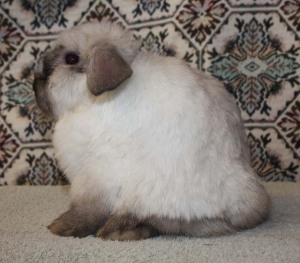
GBF's Cloudburst. Sable Point Buck. An L&R SnowBoy son. He has been chewed on, so he looks ratty right now.
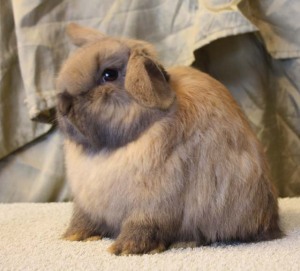
KKR's Ebony. Tort Doe. Another joint breeding with Ki. I get to keep Ebony and her brother Eli below. Both sired by L&R SnowBoy.
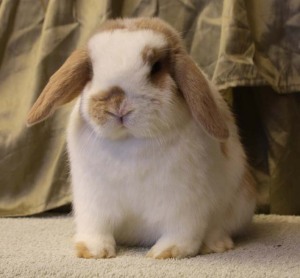
GBF's Gobi. She is part of my Chocolate Project. I know she looks like a broken orange, but she is not an Agouti. So, she is either a Broken Chocolate Tort or Lilac Tort.
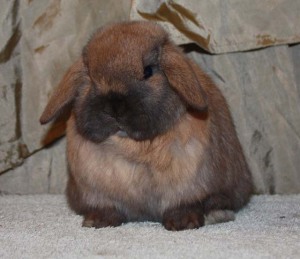
GBF's Zaynee. This little doe went home with Ki, as she was from a joint breeding - my doe, her buck.
We Are Published!
04 Dec 2010 Leave a comment
in Uncategorized Tags: English Angora Rabbits, magazine, Mary Jane
Several months ago, I was contacted by Genevieve Charet, a Writer/Copy Consultant for MaryJanesFarm Magazine. She was writing an article on angora’s and wanted to use some of my pictures and ask me some questions. A couple of days ago, she sent me an email with the article attached! Here I am (rather, one of my bunnies, the pointed white on the first page) in print!
I had to pull the copy of the article because of copyright issues. If you’re curious about it, contact me. 🙂
I did not agree with her comment that it was better to get a doe versus a buck though. My experience is that does are more territorial then bucks and almost always recommend a buck as a pet over a doe.
Useful Evans Feature
01 Dec 2010 Leave a comment
in Uncategorized Tags: Chore List, Evans
A lot of us rabbit breeders use Evans Software for our pedigrees and what-if-scenarios in breeding. I also use the “TaskMaster” feature. Yesterday, after using this software for what, almost 3-years now, I finally realized something that I should have been doing. Dah!
On the TaskMaster Chore List Screen, there is a button EDIT CHORE PROFILE. This is where you set the parameters for when you want to palpate, wean litters, re-breed does, etc. Yesterday, I noticed the CUSTOM CHORE SETTING FOR THIS BREED section on this screen. It allows 3 custom chores to be entered.
I added “Clean Box” 7 days after kindling, “Clean Box” 14 days after kindling, and “Worm Kits” 35 days after kindling. Now, when I print out my “Task List” it will automatically tell me to clean the nest boxes at 1 and 2 weeks so I don’t forget. Also, I was not necessarily consistent in worming all my youngsters. Having a chore set at 5 weeks of age is perfect. (I have noticed that there are fewer ‘faders’ when the kits are wormed before any symptoms appear. See the article by Barbie Brown below).
After adding these parameters, I printed out my Chore List yesterday and Cleaned 1 box, and Wormed 10 other litters. Unless the doe was already re-bred, I wormed her right along with the kits (I usually don’t re-breed a doe until the kits are 6-weeks). In a previous post (see below), I commented about using the cage tags to keep track of litters, etc. On back of the Pink Litter Tag, I noted “11/30 wormed SG”, which means I wormed the kits with SafeGuard on Nov 30th. I made the same note on the back of the dam’s blue ID Tag.
Related Posts
Related Articles
Responses to Search Strings
01 Dec 2010 Leave a comment
I like to look at the ‘dashboard’ WordPress provides – one feature is that it shows you the search strings people used to find your blog. As I find new questions, I will add them to this Blog entry:
“what is the difference between lilac and blue rabbits?” 1-21-11
A blue bunny is a dark blue color. Genetically, it is aaB_C_ddE_. The two little d’s are responsible for the dilute color (blue in this case).
Now, a Lilac, is Blue but with Chocolate also. They are much lighter in color then a solid Blue – more gray actually. Gentically, aabbC_ddE_. The two little b’s are responsible for the chocolate color. Chocolate and Dilute together = Lilac. So if you had a chocolate rabbit and blue rabbit, the lilac would be a color inbetween.
“what does bunny bew ssd mean”
Every hobby has it’s share of acronyms. BEW stands for Blue-Eyed White (there are also REWs – Ruby-Eyed Whites). SSD stands for Solid Senior Doe (a doe that is 6-months of age or older). Here are all the class acronyms for Hollands:
SSB – Solid senior buck; SSD – Solid senior doe; SJB – Solid junior buck; SJD – Solid Junior Doe.
BSB – Broken senior buck; BSD – Broken senior doe; BJB – Broken junior buck; BJD – Broken junior doe.
“do all rabbits eat their first litter of babys” 2-3-2011
No, they don’t. With my does, they seem to only do this if the babies are born dead, have died once born or if they have a terribly stuck kit and they are just trying to get that ‘thing’ out of them. They don’t kill them by eating them. (I did have one, and needless to say, she is not here anymore. I can tolerate a lot of things, but that I won’t.)
Some does will do that though. And that is not a good thing. It is not uncommon for a first time mom to lose her litter. Wait two days and rebreed her. When she is ready to have that litter, keep a very close eye on her.
“rabbit had 1 bunny, seems little cold”
It probably is. If a doe only has 1 or 2 kits, it’s difficult for such a small litter to keep warm without some help. First, you need to thoroughly warm the kit. If you have another litter you can foster the kit to, that is easiest. Otherwise, I bring small litters into the house until they are about a week old. The house is warm and I can keep a close eye on them. After a week, they have some hair on their bodies and they are stronger. Make sure the nest box has plenty of warm bedding material in it to help keep them toasty. Bring mom in to nurse the kit(s) once a day.
“my rabbit just had babies what do i do”
I’m assuming this was a ‘surprise’ litter. Gather those babies up off that wire. It is a ‘wives tail’ that mama bunnies will leave their babies if you touch them.
Get mom bunny a nest box quick. Put some pine shavings on the bottom if you have some, and then add some straw. Gather all/any hair that she has pulled and put that in a nice little pocket near the back of the box. If there isn’t much hair pulled, you need to add extra. Pet stores sell bedding material if you need more. This time of year (around here anyway), the kits will freeze if they aren’t well covered. Make sure the kits are warm, and put them in the box.
If you don’t have an ‘official’ nest box, you can use a plastic container, like Rubbermaid or Sterlite. These are easier for mom bunny to knock over though, so I use cable ties to secure them to the side of cage. If nothing else, a box will work in a pinch.
If the kits are cool or cold, you need to warm them up. I have two methods, 1) slip them under your shirt and into your bra if you’re a woman. (I know – AHHH! When I first read about doing that I thought the person was insane. But, it’s warm and it keeps them close to your skin). Otherwise, put them under your shirt and cradle them close to your skin to slowly warm them. Gently massage them and blow into their faces to get the blood moving and to help them breath. 2) Warm kitchen towels up in the dryer. Put the kits in the warm towels, and rotate the cool towels out with warm ones. I do not use heating pads as you can over heat them easily.
Personally, I would keep the box in the house a couple of days and make sure the kits are doing OK. Bring mom in 1x a day to nurse them (mom bunnies only nurse 1x a day, then hop out of the box and go about their business). Make sure each baby is nice and fat after she is done. When you are confident mom bunny is doing a good job and kits seem healthy, take the box out to her cage. Check them daily.
Never put anything in the nest box that can ravel! The kits can get tangled. If you add ‘material’, use only fleece as it is warm, soft and will not ravel.
“how can i tell a tom turkey from a hen turkey”
This can be hard when the turkeys are young.
- It’s easy when the Tom’s are old enough to ‘display’ – when they open their tail feathers up big and beautiful. Hens will not do that.
- The snood on the top of the beak will be larger if it’s a Tom – it will grow and get long if it’s a Tom and he’s a bit worked up. The snood of a hen stays small and close to their beak.
- Toms and hens make slightly different sounds when young. Only the adult male turkey makes the gobble sound. The female turkey makes a gentle clucking or clicking sound.
- If you have multiple toms, they will start to fight amongst themselves to establish the ‘pecking order’.
- I’ve noticed my tom’s seem to stick together in a group, and the hens tend to be off together in another group at times.
- This is a good link for a table of differences with pictures, Sexing Turkeys..
“why are the lop rabbits eyes not opening”
Kits usually open their eyes anywhere between 10 and 14 days. If you notice one eye opening and not another on a kit, or other kits in the box are opening their eyes, but another kit isn’t, check the eyes of the suspect kit. Sometimes the eyes will crust a bit, sealing the eyelid closed and the bunny can’t open the eye. DON’T just try to force the eyelids apart. Use a warm, damp, soft cloth or cotton ball and gently swab at the eye lid, wiping away any ‘goop’. Gently work to open the eye. Check the eye daily to make sure it is staying open and not sealing back shut. If the eye continues to goop shut, then there is probably an infection in it that needs to be addressed.
If the eye is left closed for too long, it can cause permanent damage to the eye causing the rabbit to be non-showable or worse (blind or even eye loss).
A factor in eyes not opening is the nest box itself.
- Nest boxes must be clean. Those little babies pee and poop in there. Have you picked up a baby after it’s been fed and had it pee on you? Well, they do that in the box. All of them. Every day. Yuck. The bedding and box can get wet and nasty. Disinfect the nest box between each litter (I use bleach or Synergy, whichever I find first) and thoroughly dry it (hot sun is perfect).
- Once clean, good bedding choices are also a factor. This is how I prep a box for a new litter: I put a couple cups of Equine Fresh on the bottom. Then, pine shavings, followed by clean straw. The Equine Fresh helps to absorb the urine and pull it away from the babies and away from the box. Shavings add insulation. One week after the kits are born, I dump out all the old bedding and add all fresh to help eliminate any eye issues. At two weeks I clean the box again. At three weeks I take the box out.
“blue sealpoint rabbit what would be best colour to put her to”
A Blue Seal Point. Ooh. A very cool color. Technically, not showable for Hollands, but cool non-the-less. The genotype for that would be aaB_c(chl)c(chl)ddee. What you would breed that rabbit to would depend on what colors you want to produce.
The first thing NOT be breed it to would be anything Agouti A or Tan a(t). You would most likely end up with more non-showable colors. That leaves ‘aa’ colors.
A tort or self based REW would be great – all offspring would be Sable Points and/or Siamese Sables depending on the extension gene of the REW. REWs are not all that common though. A Pointed White would also work well.
Any tort or self color would also be fine. Remember that all babies from this rabbit will carry c(chl) and dilute. A Blue Tort or Blue would guarantee all the offspring are also Blue varieties. Depending on what you want to get, you might not want to breed it to anything that carries c(chl), as your chances of getting more Seals would be 50%.
“what is the difference between sable point and frosty point”
A Sable Point is aaB_c(chl)_D_ee. This is basically a Black Tort with the light chin gene instead of “C”. The ARBA Standard of Perfection explains: “Color is to be a rich sepia brown on the nose, ears, feet, legs, and tail. Marking color is to shade rapidly to a rich cream body color. The entire body is to be a creamy color, with white undercolor. Some slightly darker shading is permissible on the saddle, but highly undesirable. Body surface color is to be lighter than the point color to give the proper contrast. Eyes: Brown.”
A Frosty Point (or Frosty) is A_B_c(chd)_D_ee. This is in the wide-band group of Hollands because it is an Agouti with non-extension. Instead of the light chin gene like the Sable Point has, it has the dark chin gene. The Standard of Perfection describes a Frosty as: “Color is to be light pearl, as even as possible. When blowing into the coat, a slight ring may appear at the tip of the hair shaft. Slightly darker tint on nose, ears, legs, and feet is permissible. Belly color and undercolor is to be light pearl to white. White on underside of tail IS permitted. Eyes: Brown or Blue-gray.”
